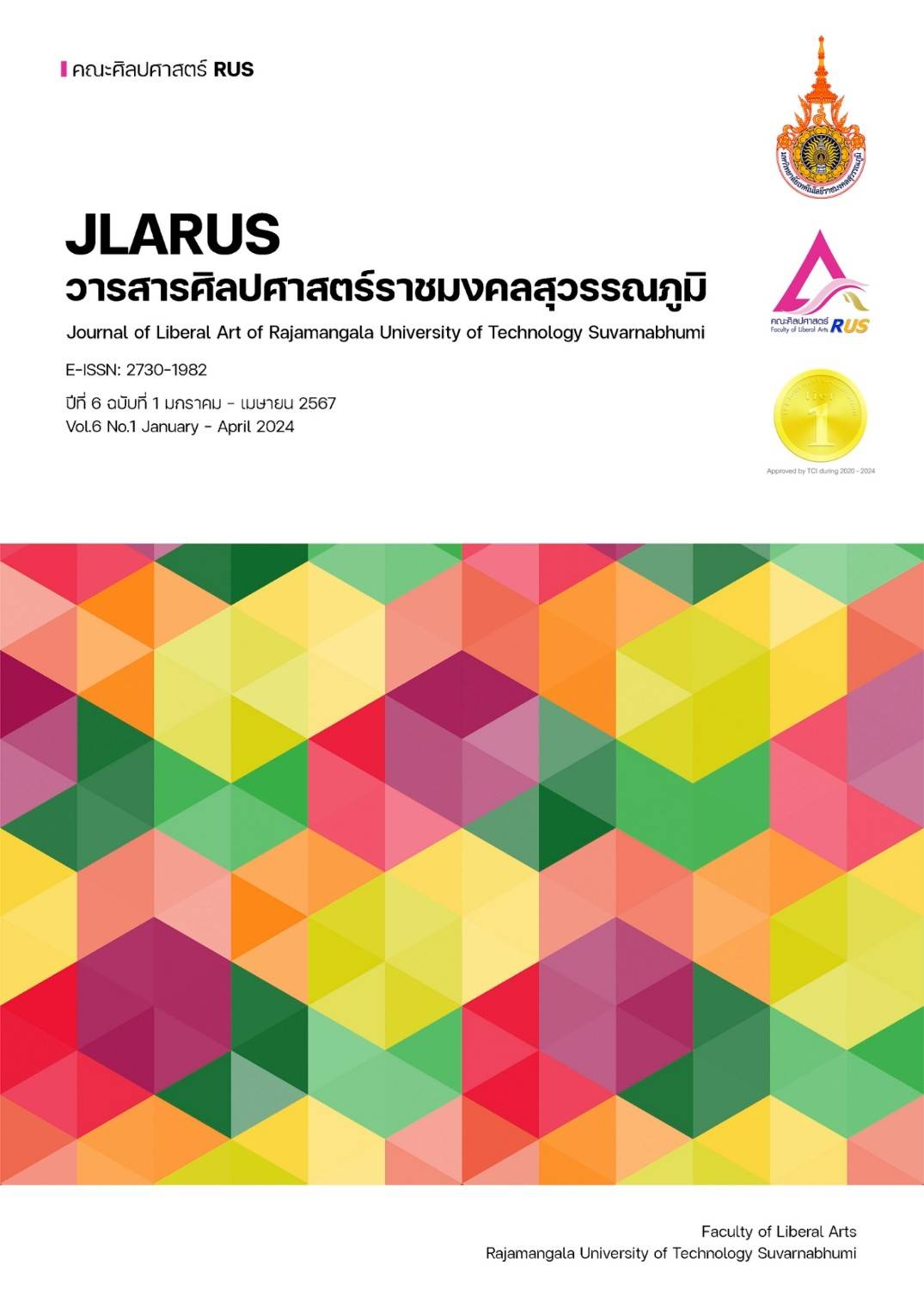INNOVATION IN MANAGEMENT AND TECHNOLOGY FOR DEVELOPING SEA POWER IN THAILAND
Main Article Content
Abstract
This article aims to. study administrative innovation and military technology. That affects the effectiveness and operational capacity of the army. To study the current direction of management and technology innovation. To guide the development of Thailand's sovereignty. There are the following findings 1) Military innovation and technology 2) Geopolitical factors Geographical problems can use the technology of digging canals to connect the sea or ship-lifting bridges (land bridges) to solve geographic problems that are not consistent with the development of the Thai state's ocean power. But still need to develop Engineering and materials science to support the use of modern technology in correcting existing geopolitical shortcomings 3) Factors in Security policy direction. Technology should be used to help build political mechanisms and create a strong political system. It consists of using artificial intelligence technology to help monitor government work in order to build a strong political system. Including the use of modern innovations to help develop the characteristics of the population 4) Factors in naval power and maritime commerce. Must accelerate the creation of technology and innovation from within the country. There is a systematic ship testing tank. To study the forces acting on the ship's hull and the resistance of the fluid. The knowledge gained from the tests will greatly help the development of related science and technology. It is an important variable that causes the development of technology related to Thailand's ocean power in the future.
Article Details

This work is licensed under a Creative Commons Attribution-NonCommercial-NoDerivatives 4.0 International License.
References
กรมทรัพยากรทางทะเลและชายฝั่ง. (2556). สถานการณ์กัดเซาะชายฝั่งทะเลไทย. สืบค้น 15 มกราคม 2567. จาก http://marinegiscenter.dmcr.go.th/km/coastalerosion_doc9/#.VXFe ZdLtm kp.
กรมพัฒนาที่ดิน. (2565). แผนปฏิบัติราชการ กรมพัฒนาที่ดิน ( พ.ศ. 2566 - 2570 ). สืบค้น 15 มกราคม 2567. จาก https://www.ldd.go.th/FileUpload/PlanLDD/Plan5yearLDD .pdf.
กองความมั่นคงทางทะเล. (2565). “กองเรือพาณิชย์” หนึ่งใน “สมุททานุภาพ” และพลังอำนาจของประเทศ”. เอกสารวิชาการวิเคราะห์สถานการณ์ความมั่นคงฯ ฉบับที่ 5 2565 สำนักงานสภาความมั่นคงแห่งชาติ. กรุงเทพมหานคร: กองความมั่นคงทางทะเล สำนักงานสภาความมั่นคงแห่งชาติ.
โกวิท วงศ์สุรวัฒน์. (2550). ภูมิรัฐศาสตร์. (พิมพ์ครั้งที่ 7). กรุงเทพมหานคร: วาสนา.
คณะทำงานพิจารณาและจัดทำ อทร.ด้านการศึกษาชั้นสูง. (2544). การป้องกันและรักษาผลประโยชน์ของชาติทางทะเล, เอกสารอ้างอิงของกองทัพเรือหมายเลข 8002. กรุงเทพมหานคร: กองทัพเรือ.
นรพัชร เสาธงทอง. (2559). การขุดคอคอดกระกับความมั่นคงทางภูมิรัฐศาสตร์ในภูมิภาคเอเชียตะวันออกเฉียงใต้. วารสารวิชาการมหาวิทยาลัยปทุมธานี, 8(1), 143-153.
พงศ์สรร ถวิลประวัติ. (2546). สมุททานุภาพ. ใน เอกสารประกอบการบรรยายพิเศษ คณะวิศวกรรมศาสตรศรีราชา สาขาวิศวกรรมต่อเรือและเครื่องกลเรือ. ชลบุรี: มหาวิทยาลัยเกษตร์ศาสตร์ วิทยาเขตศรีราชา.
พรพิมล ระตาภรณ์. (2020). การวิเคราะห์องค์ประกอบเชิงยืนยันสมรรถนะด้านเทคโนโลยีสารสนเทศ และการสื่อสารของอาจารย์มหาวิทยาลัยราชภัฏกลุ่มภาคตะวันออกเฉียงเหนือ (Doctoral dissertation). ปทุมธานี: มหาวิทยาลัยรังสิต.
สถาบันเทคโนโลยีป้องกันประเทศ. (2554). แนวโน้มของเทคโนโลยี และความมั่นคงทางทะเล: แรงขับเคลื่อนเพื่อการพัฒนาสมุททานุภาพของไทย. กรุงเทพมหานคร: สถาบันเทคโนโลยีป้องกันประเทศ กระทรวงกลาโหม.
สราวุธ ลักษณะโต. (2557). การพัฒนากิจการพาณิชยนาวีไทย: กองเรือพาณิชย์และนายประจำเรือ. Veridian E-Journal, 6(1). 243-252.
สามารถ จำปีรัตน์. (2556). สมุททานุภาพ. นครปฐม: นาวิกศาสตร์.
สามารถ จำปีรัตน์. (2556). ตอนจบองค์ประกอบสมุททานุภาพ. นครปฐม: นาวิกศาสตร์.
สำนักงานเลขาธิการรัฐสภา. (2566). ความคุ้มค่าของการขุดคลองเชื่อมสองฝั่งทะเลภาคใต้ของไทย. สืบค้น 15 มีนาคม 2567. จาก senate.go.th/view/386/รายละเอียดข่าว/Activities Committee/65/TH-TH.
อรรถพร บรมสุข. (2553). การขุดคลองกระกับความมั่นคงทางทะเลของไทย (วิทยานิพนธ์ปริญญารัฐศาสตรมหาบัณฑิต). ชลบุรี: มหาวิทยาลัยบูรพา.
เดชดิลก อัครพงษ์ภาคภูมิ. (2020). ความยั่งยืนของมาตรการแก้ไขปัญหาการกำกับดูแลการบินพลเรือน กรณีศึกษาการติดธงแดงจาก International Civil Aviation Organization (ICAO) (สารนิพนธ์ปริญญามหาบัณฑิต). กรุงเทพมหานคร: จุฬาลงกรณ์มหาวิทยาลัย.
Chen, L. Y., Huang, H., & Goldberg, K. (2023). Optimal Arrangement and Rearrangement of Objects on Shelves to Minimize Robot Retrieval Cost. IEEE Transactions on Automation Science and Engineering.
Hameed, H. M., Rashid, A. T., & Al Amry, K. A. (2020, June). Automatic storage and retrieval system using a single mobile robot. In 2020 International Conference on Electrical, Communication, and Computer Engineering (ICECCE) (pp. 1-6). IEEE.
Intan, A., Setiawan, A., & Maengkom, M. R. (2023). Studi Literatur terhadap Peran dan Manfaat COBIT 2019 dalam Tata Kelola Teknologi Informasi di Indonesia. Innovative: Journal Of Social Science Research, 3(5), 1681-1692.
Jiang, H. (2023). Artificial Intelligence: An Overview. Artificial Intelligence in Anesthesiology, 1-11.
Jawad, M. M., Ali, M. H., Khaleel, A. A., & Hasan, M. F. (2023). Evaluating the performance of IT management under the implementation of the COBIT 2019 framework. Eximia, 12, 18-36.
Khan, F. H., & Fazal, M. (2019). Artificial intelligence Future of Anesthesiology. Anaesthesia, Pain & Intensive Care, 247-249.
Kiasari, S. M., & Ahmadigatab, T. (2012). To analyze the effective factors of using Information and Communication Technology (ICT) in Payam Noor University. Procedia-Social and Behavioral Sciences, 47, 24-28.
Mutiara, A. W., Wijanto, S. H., & Anindra, F. (2019, July). Information Technology Governance Process Capability Level at ABC Company (a State-Owned Enterprise in Indonesia). In Asia Pacific Business and Economics Conference (APBEC 2018) (pp. 281-287). Atlantis Press.
Suwikarma, I. M. Y., & Nita, S. (2023). Crime Prevention Conducted by the Task Unit of Patrol Ship Ditpolairud Baharkam Polri Against Transnational Crime Cases in the Indonesian Water Area (Case Study: Transnational Crime in the Riau Archipelago). International Journal of Social Science Research and Review, 6(6), 561-572.


